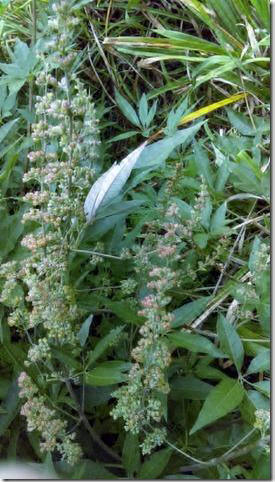Martie Young
Adams County Master Gardener

The chaste tree (Vitex agnus castus) is a summer shrub which can get quite tall in just one season. It generally dies back in the winter and sprouts again from the roots or the 1- to 2-foot stems in the spring. I learned about this shrub around 20 years ago when Penn State sent plants to be evaluated in Master Gardeners‘ Trial Gardens all across
the state. At that time it was considered just barely viable in zone 6. Now, as our weather gets warmer, it may be viable in zone 7. (The higher the zone, the warmer the weather—Florida is in zone 10.) Our plant grew for several years in our Trial Garden and then we removed it, but I kept cuttings in my own garden and it is still very much alive. This past summer, after
some really cold winter weather, it sprouted reliably in late spring and is now about 8 to 10 feet tall. And—it has been blooming since July and is still going strong in the first 2 weeks of Oct. No frost yet, but it will come—possibly before you read this article.
 The flowers on this shrub are extremely pretty—a bluish-purplish color. Its common name is summer lilac and the flowers slightly resemble the spring lilac in color. But lilac requires more water and blooms just once in the spring; vitex will
continue to bloom from July through fall and does not require additional water after establishment. Because of this, vitex is very popular in Texas. Another great attribute are the seeds which resemble peppercorns--they are reddish purple berries in color and last on the shrub for a long period. These seeds are quite attractive and can be used in flower arrangements. It
is recommended to cut off these berries throughout the summer to keep the plant blooming well. Vitex will make a great replacement in your butterfly garden for butterfly bush. You can probably find this shrub in larger nurseries that cater to native and bee gardens and certainly in plant catalogs.
The flowers on this shrub are extremely pretty—a bluish-purplish color. Its common name is summer lilac and the flowers slightly resemble the spring lilac in color. But lilac requires more water and blooms just once in the spring; vitex will
continue to bloom from July through fall and does not require additional water after establishment. Because of this, vitex is very popular in Texas. Another great attribute are the seeds which resemble peppercorns--they are reddish purple berries in color and last on the shrub for a long period. These seeds are quite attractive and can be used in flower arrangements. It
is recommended to cut off these berries throughout the summer to keep the plant blooming well. Vitex will make a great replacement in your butterfly garden for butterfly bush. You can probably find this shrub in larger nurseries that cater to native and bee gardens and certainly in plant catalogs.
The above description could also apply to the butterfly bush (Buddleia davidii) which dies back in winter and comes back in spring; it has attractive flowers that come in several colors but ugly seed pods. This plant is also sometimes known as summer lilac since it also blooms in the summer into fall. When I had a butterfly bush I always cut off
the seed pods. And most important—the butterfly bush is invasive. It could (and probably will) come up in your yard and your neighbors’ yards. No big deal—right??? But it also travels by bird droppings and other means to forests and roadside plantings. This is a bad thing and just because you can’t see it from your window, it is definitely creating havoc among native
plants. Whenever invasive plants get loose it is hard to contain them. Not many people are going to the forest or roadsides to dig them out—cutting them off is not enough. State forest workers hardly have the manpower to eliminate all the invasive plants that grow in the woods--plants such as Japanese honeysuckle, bittersweet, stilt grass, etc.
The list of invasives is long and the list of natives is becoming shorter because their habitat is being destroyed. Invasives generally grow anywhere but native plants need certain conditions of shade, sun, water, and the right soil before they can become established. I’m sure most of you have seen weeds flourishing in a sidewalk crack or rocky,
dry soil and maybe you wonder how they survive—they survive because they are stronger—they are called ‘thugs’ for a reason. You can also point to the fact that butterflies are attracted to the butterfly bush—but most of the other pollinators are not attracted to the butterfly bush flowers. Butterflies do drink the nectar but they generally do not carry pollen to other
flowers; bees, wasps, bats, and even small rodents will transfer pollen to other flowers by carrying it on their bodies or their fur. Another important point: butterfly bush and butterfly weed are NOT the same plant—butterfly weed’s Latin name is Asclepias tuberosa and it is an important member of the milkweed family. Monarch butterflies use the milkweed family of plants
as their sole pollinators.
I was outside looking at my vitex this morning—it is cloudy and cool (in the 50s) but there was a bumble bee pollinating the flowers and, as it warms and gets sunny, there will be many pollinators at the flowers—butterflies, bees, wasps, and small rodents. All of these pollinate the vitex. I know—you will say that butterfly bushes also bring
butterflies—but other pollinators are not attracted to butterfly bush.
Vitex has been cultivated since 1670 and has become naturalized throughout the South. It originally came from China. It needs full sun and well-drained soil. It can be pruned into a small tree by removing some of the main stems and all of the lower branches. This would have to be done yearly in our climate. It’s possible to create new plants by
cuttings or layering low-growing branches. The leaves are attractive and feature five leaflets in a palmately compound arrangement. They have a distinctive fragrance and the flower clusters resemble the butterfly bush flowers. They have few pests or diseases. My vitex grows in full sun and so far (probably about 10 years) I have not had problems with it. Vitex could be a
wonderful addition to YOUR garden and all the pollinators will thank you!